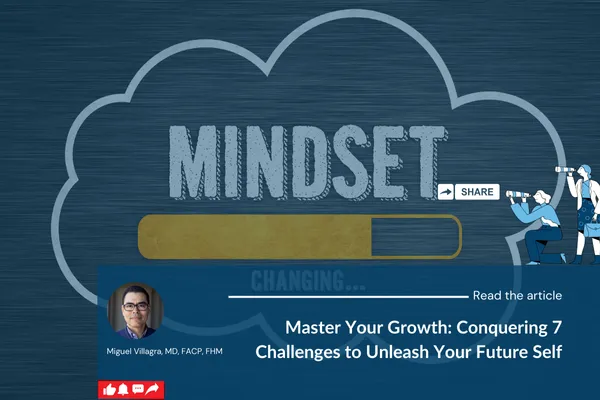BLOG POST

Master Your Growth: Conquering 7 Challenges to Unleash Your Future Self
Master Your Growth: Conquering 7 Challenges to Unleash Your Future Self
Embark on a thrilling journey of personal growth, a path filled with rich rewards and distinctive challenges. As we strive to become our best selves, we often face challenges like self-doubt, fear of failure, and external limitations that may slow our progress. These challenges, if not properly managed, can derail us from achieving the success and fulfillment we aspire to.
Crafting Your Vision: A Roadmap to Success
At the foundation of every successful personal growth journey lies a clear and compelling vision. This vision serves as a north star, guiding your daily choices and long-term efforts and ensuring that every step you take is aligned with your ultimate objectives. Having a clear, focused direction is vital not just for defining your vision but also for dealing with distractions and conflicting priorities that can block your way.
The Importance of Value-Goal Alignment
The first step in clarifying your vision is ensuring that it is deeply rooted in your core values. This alignment between what you value deeply and what you aim to achieve is essential for sustained motivation and satisfaction. Begin by identifying your core values to make this connection. Ask yourself what truly matters to you—whether it's creativity, service, innovation, family, or health—and then shape your vision around these priorities.
Developing and Enhancing Your Vision
Once you've grounded your vision in your values, the next crucial step is to define it clearly and precisely, as this alignment serves as a powerful motivator for pursuing your goals. A well-articulated vision should be specific enough to provide direction but flexible enough to adapt to changing circumstances. Consider using visualization techniques such as creating a vision board or writing a detailed description of where you see yourself in five, ten, or twenty years. These practices can help solidify your vision and make it more tangible.
However, refining your vision is an ongoing process. As you grow and accumulate experience, your evolving understanding of your desires and necessities will continually shape and refine your vision. Therefore, it’s important to regularly revisit and adjust your vision to reflect your current reality and future aspirations.
Turning Vision into Reality
With a clear vision in place, the final step is implementation, where the transformative power of translating your vision into tangible actions becomes evident. This involves breaking down your long-term vision into actionable steps and setting short-term goals that lead to your larger objectives. Consistently monitor your progress and acknowledge small wins throughout your journey. This not only keeps you motivated but also provides a clear indicator of how closely your daily activities align with your overarching vision.
Cultivating Consistent Habits
As renowned author Angela Duckworth said, 'Success is the result of small efforts repeated day in and day out,' emphasizing that consistency, not intensity, is the key to achieving lasting success. Our daily habits form the foundation for long-term success and personal growth. In shaping these habits, it's crucial to align them with the vision we've clarified, ensuring that our daily routines reflect our deepest aspirations and goals.
Key Habit Identification for Success and consistently practicing them are essential in order to create lasting success.
Strengthening productive habits
Once you've identified the habits that align with your vision, the next step is to strengthen them and make them a consistent part of your life. This involves creating a structured routine that incorporates these habits into your daily schedule. Consistency is key, so it's important to set specific times for these activities. For instance, if advancing in your career is part of your vision, dedicate time each morning to enhance your skills or knowledge in your field.
Eliminating counterproductive habits
Equally important to establishing new, beneficial habits is the elimination of those that detract from your goals. This might include reducing time spent on passive entertainment, avoiding procrastination, or cutting down on unproductive multitasking. It’s essential to be honest with yourself about these habits and take decisive action to change them. Sometimes, small adjustments, like turning off notifications during work hours or setting a bedtime routine for better sleep, can make a significant difference.
Micro-Habits: Small Changes, Big Impact
For many, the idea of introducing major changes to their routine can be daunting. This is where micro-habits come in. Micro-habits are small, manageable behaviors that can be easily incorporated into your daily life but compound over time to produce significant results. For instance, if your vision involves writing a book, you can begin by forming the micro-habit of writing just one paragraph daily. Over time, this small daily action builds up into a substantial body of work. Eventually, you will have completed an entire book.
Choosing Your Circle Wisely
The company we keep has a profound influence on our personal and professional growth. The people around us can either spur us on to greater heights or pull us down to their level of complacency. Understanding the impact of your social circle and actively curating it is therefore critical to fostering an environment conducive to your growth. Encircle yourself with people who motivate and uplift you to achieve your utmost potential.
Creating Your Circle of Genius
The concept of the "Circle of Genius" involves surrounding yourself with individuals who not only support your goals but also push you towards achieving them. These are people who challenge your thinking, broaden your perspectives, and share insights that prompt you to strive for more. Creating such a circle starts with identifying what qualities you value in others—qualities such as integrity, intelligence, ambition, and positivity. Look for these traits in current and potential relationships, and strive to foster connections that align with these values. This will ultimately lead to a more fulfilling and supportive social circle.
Embracing a Growth Mindset
At the heart of personal transformation and success lies a profound psychological concept: the growth mindset. This mindset, as opposed to a fixed mindset, thrives on challenge and sees failure not as evidence of unintelligence or lack of ability but as a heartening springboard for growth and for stretching our existing abilities.
Understanding the Growth Mindset
A growth mindset is fundamentally about believing that your talents and abilities can be developed through hard work, good strategies, and input from others. It contrasts sharply with a fixed mindset, which dictates that your talents and abilities are static and unchangeable. Embracing a growth mindset involves understanding that every experience, whether a success or a failure, is a valuable part of the learning process.
Building Your 'Sage Muscle'
In the realm of positive intelligence, embracing a growth mindset means building what is termed your 'sage muscle.' This involves developing the ability to see challenges as opportunities for improvement. To strengthen this muscle, practice reframing setbacks as chances to learn and grow. When faced with a difficulty, ask yourself, "What can this teach me?" or "How can this help me grow?" This shift in perspective can transform your approach to everyday challenges and setbacks.
Leveraging every experience
Embracing a growth mindset means that every experience, whether positive or negative, serves as a stepping stone for personal development. For example, if you receive criticism at work, instead of taking it personally and feeling defeated, view it as constructive feedback that can help you improve your skills. Similarly, when you achieve a goal, instead of merely celebrating the success, analyze what strategies worked and how they can be applied to future challenges. This mindset shift will lead to continuous growth and development.
Conquering Fear of Failure
Fear of failure is a common and natural emotion that can either stifle or fuel your progress towards personal growth. It's an obstacle that everyone faces at some point, but how you handle this fear can significantly influence your journey to achieving your best future self. Conquering this fear involves understanding its roots and learning to harness it as a motivator rather than allowing it to be a barrier.
Understanding the nature of fear
Fear of failure often stems from the weight of expectations—either our own or those imposed by others—and the perceived consequences of not meeting them. It's important to recognize that fear is fundamentally a psychological response designed to protect us from perceived threats. In the context of personal growth, these threats are not typically physical but rather threats to our ego or self-identity.
Reframing Failure
The first step in conquering fear of failure is to reframe what failure means to you. Instead of viewing it as a negative end point, see it as a crucial learning step in the process of experimentation. This shift in perspective changes the role of failure from being a stopping point to being a stepping stone on the path to success. Each failure is simply feedback that provides insights into what doesn’t work, guiding you to refine your approach.
Embracing and Owning Your Failures
Taking ownership of your failures is a powerful way to diminish their sting. Acknowledge your mistakes and missteps openly instead of hiding from them. This not only reduces the fear associated with failure but also enhances your credibility and relatability as a leader or influencer. Learning from these failures involves analyzing what went wrong, understanding how different choices could lead to different outcomes, and applying these lessons moving forward.
Creating a Safe Space for Risk-Taking
To effectively conquer fear of failure, create environments in your personal and professional lives where taking calculated risks is encouraged and the consequences of failing are minimized. This could mean setting up small, low-stakes experiments in which failure has little to no material impact but provides valuable lessons. By regularly stepping out of your comfort zone and experiencing that you can survive and learn from failure, you gradually reduce the fear associated with it.
Letting go and moving on
Sometimes, conquering fear of failure also means knowing when to let go of unfruitful projects or pursuits. Not every effort will result in success, and part of learning to deal with failure is recognizing when continued investment in a failing endeavor is no longer worthwhile. This doesn’t mean you’ve failed; rather, it means you are making a strategic decision to redirect your resources more effectively. Ultimately, it is important to remember that failure is not the end but an opportunity for growth and improvement.
Managing Overwhelm and Avoiding Burnout
In the pursuit of personal and professional growth, it's easy to fall into the trap of over commitment, leading to overwhelm and eventually burnout. Learning to manage overwhelm and prevent burnout is crucial for maintaining productivity and achieving sustained success.
Recognizing the Signs of Overwhelm and Burnout
The first step in managing overwhelm is recognizing its signs. These can include feeling constantly stressed, a lack of enthusiasm about work or daily activities, physical fatigue, irritability, and a decrease in performance. Burnout takes this a step further, leading to emotional exhaustion, a sense of reduced accomplishment, and sometimes detachment from the job and personal life. Acknowledging these symptoms early is key to taking proactive steps to address them.
Setting clear boundaries
One of the most effective ways to manage overwhelm is to set clear boundaries between work and personal life. This might mean defining specific work hours, ensuring that you have time set aside for relaxation and social activities, or being selective about the projects and commitments you take on. Learning to say no is an essential skill in boundary-setting, helping you avoid overcommitment and the stress that comes with it.
Prioritizing Tasks and Delegating
When faced with a mountain of tasks, prioritize them based on their urgency and importance. Tools like the Eisenhower Box can help you decide which tasks to do immediately, schedule for later, delegate, or eliminate. Delegating tasks, when possible, can also relieve the pressure and help distribute the workload more evenly. This not only helps you manage your time more effectively but also enables you to focus on tasks that are more critical or fulfilling.
Incorporating regular breaks and recovery time
To prevent burnout, it's crucial to incorporate regular breaks into your schedule. This can be as simple as taking short walks during the workday, practicing mindfulness or meditation, or having longer periods of downtime between major projects. Regular vacations or staycations where work is completely put aside can also be highly beneficial. These breaks are essential for mental and emotional recovery, refreshing you to return to your tasks revitalized.
Reflecting on Success
Reflection is an essential tool in the arsenal of personal growth, acting as both a mirror and a map. It allows us to look back on our experiences to understand what we did well and what could be improved, and to plan forward-thinking steps toward our future goals. Regular reflection ensures that we remain aligned with our core values and vision and helps us adjust our strategies to better meet our objectives.
The Power of Reflection in Personal Growth
Reflection gives us the opportunity to pause amidst the busyness of our daily activities and think deeply about our recent experiences. This practice helps solidify what we learn each day and improves our decision-making for similar future scenarios. It also boosts self-awareness, helping us understand our intrinsic motivations, emotional triggers, and behavioral patterns. Through reflection, we can identify areas of strength and pinpoint weaknesses that need attention.
Introducing the '3-3-3 Rule' for Journaling
One effective method for incorporating reflection into your routine is through journaling using the '3-3-3 rule'. This technique involves writing down three key elements:
Three Things You Are Grateful For: Starting your reflection with gratitude helps to set a positive tone and shifts your focus from what's lacking to what's abundant in your life. This practice can enhance your overall mental well-being and shift your perspective to one of abundance and opportunity.
Three Wins of the Day: Reflect on three things you accomplished or did well during the day. This can range from small victories, like completing a task on time, to major achievements, like successfully leading a project. Recognizing these wins boosts your confidence and reinforces successful behaviors.
Three Actions for Tomorrow: End your reflection by identifying three specific actions you plan to take the next day. These should align with your long-term goals and help advance you toward them. Planning ahead not only sets the stage for a productive day but also helps you stay focused and aligned with your overall vision.
Establishing a Regular Reflective Practice
To make reflection a habit, schedule a regular time each day for this practice. Many find that reflecting in the evening allows them to review the day’s events and plan for the next day. However, choose a time that suits your schedule and when you can be calm and undisturbed. The key is consistency, so stick to your chosen time every day.
Conclusion:
The journey of self-improvement is not just about reaching a set of predefined goals but about continuously evolving and adapting to become the person we envision. It requires clarity of vision, resilience in the face of adversity, and the courage to step out of our comfort zones. However, it's not uncommon to feel overwhelmed by the complexities of life’s demands, which can cloud our vision and dampen our spirits.
TAKE PART IN OUR SURVEYS

Gain insights into your current MENTAL and EMOTIONAL STATE.

This survey aims to understand the current state of HAPPINESS and WELL-BEING among physicians and to gather INSIGHTS on effective strategies for fostering JOY in the medical profession.
TAKE PART IN OUR SURVEYS

Gain insights into your current MENTAL and EMOTIONAL STATE.

This survey aims to understand the current state of HAPPINESS and WELL-BEING among physicians and to gather INSIGHTS on effective strategies for fostering JOY in the medical profession.
Unlock Your Full Potential with Our Transformative Programs!
Join the Movement: Subscribe for Healthcare Innovation & Career Tips!
Physician Well-being & Resilience: Strategies for managing stress and burnout. Building emotional intelligence and mental fitness.
Positive Leadership for Physicians: Developing positive communication and conflict resolution skills. Leading with empathy and emotional intelligence.
Physician Career Transition or Pivot: Setting meaningful goals and achieving work-life integration. Navigating career challenges and transitions.
CLICK TO WATCH THE VIDEO...
Join the Movement: Subscribe for Healthcare Innovation & Career Tips!
Physician Well-being & Resilience: Strategies for managing stress and burnout. Building emotional intelligence and mental fitness.
Positive Leadership for Physicians: Developing positive communication and conflict resolution skills. Leading with empathy and emotional intelligence.
Physician Career Transition or Pivot: Setting meaningful goals and achieving work-life integration. Navigating career challenges and transitions.
CLICK TO WATCH THE VIDEO...
355 E Plumb Lane #1098, Reno, NV, 89502, USA
915-800-0690
Elevate Your Leadership and Career
Gain the tools and strategies needed to become a more effective and inspiring to our fellow physicians, entrepreneurs and other sectors. Follow us on social media, sign up for our newsletter and engage with our community to stay inspired, informed, and connected on your journey of transformation.
SUBSCRIBE TO OUR NEWSLETTER
Elevate Your
Leadership and
Gain the tools and strategies needed to become a more effective and inspiring to our fellow physicians, entrepreneurs and other sectors. Follow us on social media, sign up for our newsletter and engage with our community to stay inspired, informed, and connected on your journey of transformation.
SUBSCRIBE TO OUR NEWSLETTER
Copyright @ 2024 Adoctorsjourney, LLC
All Right Reserved.







